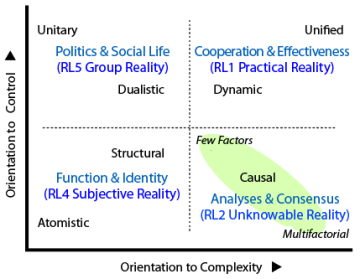Disturbing Implications of Depiction
The Story So Far

We start with essential reality or as spiritual traditions would say with capitals: Absolute Reality. This is reality prior to any human intervention or any personal functioning. This reality is raw and given. It is not even unknowable because the notion of knowing is human. It is the context within which personal functioning—the will and human endeavours—must occur.
Bringing essential reality into consciousness is an act of will, and will-based endeavour, the , is about altering that reality. The initial analysis of reality in terms of personal functioning revealed that each interacted differently with essential reality. In that analysis, the was simply one of 5 forms of human reality-and-truth.
Even then, there was an oddity in regard to the :
being practical and being investigative were concerns of the man-in-the-street and scientists.
being personal and being group-based enabled the psycho-social reality everyone uses.
being purposive and involving willingness were used to select a specific domain reality form.
So what about ?
Answer: In the present analysis, it has become evident that is the hidden controller and energizer.

The Ethical Nature of Depiction
The paradigms used for depiction are not merely optional cognitive stances or intellectual approaches. They are value-laden lenses that have consequences for what typically gets protected and what typically gets harmed, what is humanized and what is mechanized, what requires reflection and what celebrates mindlessness.
Some paradigms, while offering specific benefits, appear particularly vulnerable to failure, misuse, corruption, or over-extension, especially when followers are vulnerable, systems are under strain, or outcomes are ambiguous. In defence, it can be argued that change is difficult and the future is unknown so that, corruption and criminality apart, honest mistakes can be made. However the paradigms control how mistakes are handled and some may weaken or preclude anticipation and learning.
Other Principal Typologies do not have a comparable in-built moral-ethical element when selecting one Type rather than another.![]() Check
Check
Intelligent people may find themselves using any of the paradigms, and it is evident that the paradigm (like all value systems) determines choices, with intelligence functioning in the service of the paradigm.

The difference and difficulty with the is that along with their ethical charge, they construct and perceive reality in particular forms that belong to other Domains.
The New Realization
The original analysis in the Architecture Room (prior to this detailed investigation of change) simply (and correctly) proposed that reality is constructed in the : this constructed reality is based on a self-interested perspective and presented as a persuasive narrative.
What that formulation omitted to say, but we have now discovered, is that particular end up doing the construing by using reality-truth forms intrinsic to the other 4 Domains, and in a fixed pattern.
As explained in the previous topic, group reality () which shapes politics and social life is handled by paradigms that are morally problematic. Simplistic thinking is the default for social debate, and the stability that underlies preservation of institutions and culture comes from thinking that demands conformity denies error or failure and does not distinguish amongst individuals. These two problematic paradigms are the essential means by which human beings organize into collectives.

![]() Reminder of the Other Quadrants
Reminder of the Other Quadrants
Choice of Paradigm = Choice of Reality
Perhaps the protean nature in is not surprising. After all, the primal need for the is conjectured to be fitness, and the psychosocial pressure is conjectured to be acceptability. Neither fitting in nor acceptability has any obvious direct relationship to integrity, betterment or effectiveness
It now seems undeniable that the via its plays a central role in choosing the form of reality and truth being used in everyday life.
But what about the role of and in selecting reality as proposed in the initial conception? The answer is that where a person is involved in:
- during a ..or
- in a ..or
- to provide a ..or
- within their ,
then the associated reality form springs into life of its own accord. and are subservient in those cases. So, at least in those four Domains, there is no issue of choice in regard to the reality-truth form after all.

The issue of selecting a reality-form only emerges in relation to because this raises the requirement to choose a —and each paradigm uses a distinctive reality form when construing a situation and asserting the truth of that depiction.
is likely activated on the basis of features like desires for control or for growth and tolerance of complexity, but gets focused and energized by particular benefits:
•Mastery •Stability •Simplicity •Development
•Framework •Independence •Prediction.
applies in the use of any paradigm, and it may play a role in selecting a paradigm that is needed but is personally unpalatable. becomes a particular issue when there is an urge to make things better—as in the rationale for TOP. The application of with its pressure for selflessness and rejection of unbalanced, unenlightened self-interest is particularly relevant to overcome evils like slavery, war, poverty, ignorance, exploitation and abuse.
The reaction to the thought "it doesn't have to be like this" has led to a somewhat disturbing and sad conclusion: for the most part, it does have to be like this because effective achievement to improve personal and social life is intrinsically so difficult.
Effective achievement depends on the most grounded reality form, , but the associated depiction paradigms, and , demand:
► a systems perspective (too complicated & socially unsupported),
► openness to critical feedback and uncertainty (too stressful & unpleasant),
► concern for others and the environment (too selfless and unpolitical).
remains relevant, but it seems that only can keep the effort going through thick and thin.
Now:
- Explore more about reality forms and THEE domains.
- Return to the Review.
Originally posted: 20-Apr-2025.